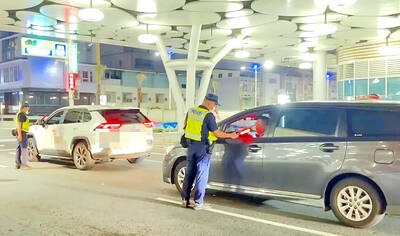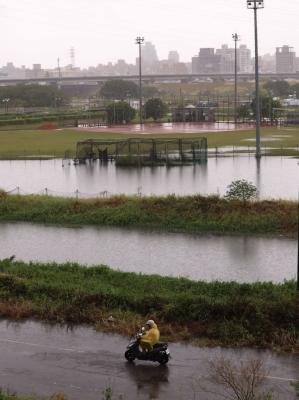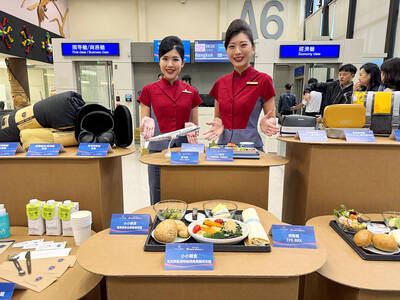National Synchrotron Radiation Research Center researchers yesterday announced the discovery of a detox mechanism of typhoid bacteria, which allows the bacteria to repel antibiotics and develop drug resistance, while the findings could help develop medicine to inhibit drug resistance.
Researchers Chen Chun-jung (陳俊榮) and Jean Yuch-cheng (簡玉成) analyzed the structure of Salmonella enterica and discovered a channel-like structure on the bacteria’s membrane protein, which could capture antibiotics and toxins inside the bacteria and remove them via the channel structure.
The channel structure is 300,000 times narrower than a human hair, Chen said, adding that the team discovered it by subjecting the protein crystals — assemblages of protein cultivated for study by X-ray or other light sources — of the bacteria to synchrotron radiation at both the Taiwan Light Source synchrotron in Hsinchu City and the SPring-8 synchrotron in Harima, Japan.
The synchrotron is a type of particle accelerator that allows for the observation of atomic structure through a sustained beam of electromagnetic waves on different wavelengths brighter than that from an X-ray tube.
Twenty-one million new cases of typhoid fever and more than 200,000 deaths occur annually worldwide and antibiotic therapy is the major treatment for typhoid fever, while it often has limited effect due to the bacteria’s ability to “pump out” antibiotics, Chen said.
The same channel structure has also been discovered on other bacteria, such as Escherichia coli and Staphylococcus aureus, which could cause serious food poisoning and post-surgery infections respectively, Chen said, adding that the team’s work could enable pharmaceutical companies to design drugs that block the channel to reduce the bacteria’s drug tolerance.
Traditional medicine development selects about 250 types of compounds from 5,000 to 10,000 kinds of small molecules for animal testing before narrowing down to less than 10 compounds for human trials, which generally take 15 years, as traditional X-ray devices take a day to analyze the atomic structure of a molecule, while the Taiwan Photon Source synchrotron in Hsinchu could lower the analysis time to 30 seconds and the entire development process to three weeks, Jean said.
“Over the past 18 years, there have been six Nobel Prizes awarded to scientists who use synchrotron in combination with protein crystallography to understand the structure of proteins. The Taiwan Photon Source synchrotron is expected to boost Taiwan’s number of Nobel Prize winners,” Jean said.

TRAFFIC SAFETY RULES: A positive result in a drug test would result in a two-year license suspension for the driver and vehicle, and a fine of up to NT$180,000 The Ministry of Transportation and Communications is to authorize police to conduct roadside saliva tests by the end of the year to deter people from driving while under the influence of narcotics, it said yesterday. The ministry last month unveiled a draft of amended regulations governing traffic safety rules and penalties, which included provisions empowering police to conduct mandatory saliva tests on drivers. While currently rules authorize police to use oral fluid testing kits for signs of drug use, they do not establish penalties for noncompliance or operating procedures for officers to follow, the ministry said. The proposed changes to the regulations require

The Executive Yuan yesterday announced that registration for a one-time universal NT$10,000 cash handout to help people in Taiwan survive US tariffs and inflation would start on Nov. 5, with payouts available as early as Nov. 12. Who is eligible for the handout? Registered Taiwanese nationals are eligible, including those born in Taiwan before April 30 next year with a birth certificate. Non-registered nationals with residence permits, foreign permanent residents and foreign spouses of Taiwanese citizens with residence permits also qualify for the handouts. For people who meet the eligibility requirements, but passed away between yesterday and April 30 next year, surviving family members

Taipei, New Taipei City, Keelung and Taoyuan would issue a decision at 8pm on whether to cancel work and school tomorrow due to forecasted heavy rain, Keelung Mayor Hsieh Kuo-liang (謝國樑) said today. Hsieh told reporters that absent some pressing reason, the four northern cities would announce the decision jointly at 8pm. Keelung is expected to receive between 300mm and 490mm of rain in the period from 2pm today through 2pm tomorrow, Central Weather Administration data showed. Keelung City Government regulations stipulate that school and work can be canceled if rain totals in mountainous or low-elevation areas are forecast to exceed 350mm in

China Airlines Ltd (CAL) yesterday morning joined SkyTeam’s Aviation Challenge for the fourth time, operating a demonstration flight for “net zero carbon emissions” from Taiwan Taoyuan International Airport to Bangkok. The flight used sustainable aviation fuel (SAF) at a ratio of up to 40 percent, the highest proportion CAL has achieved to date, the nation’s largest carrier said. Since April, SAF has become available to Taiwanese international carriers at Taipei International Airport (Songshan airport), Kaohsiung International Airport and Taoyuan airport. In previous challenges, CAL operated “net zero carbon emission flights” to Singapore and Japan. At a ceremony at Taoyuan airport, China Airlines chief sustainability